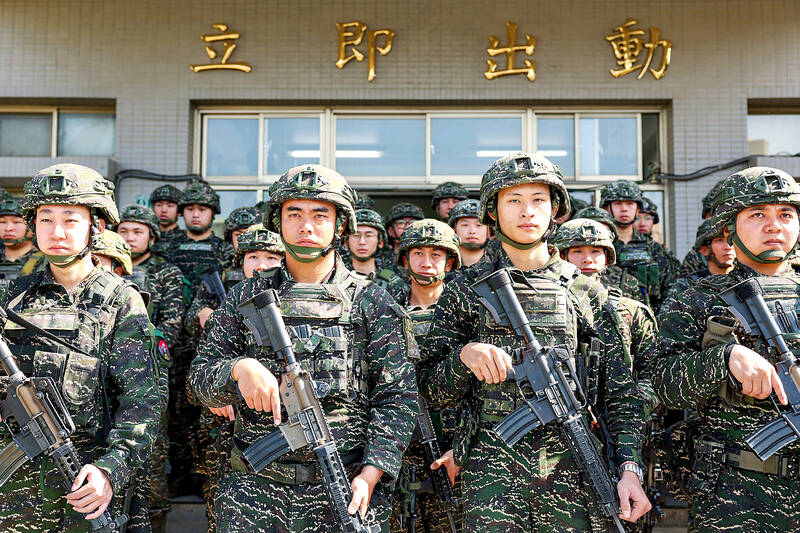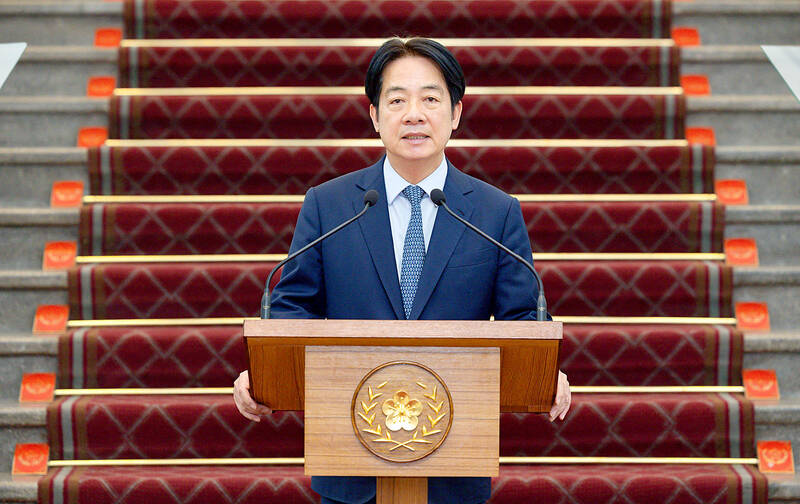President William Lai’s (賴清德) March 13 national security speech marked a turning point. He signaled that the government was finally getting serious about a whole-of-society approach to defending the nation.
The presidential office summarized his speech succinctly: “President Lai introduced 17 major strategies to respond to five major national security and united front threats Taiwan now faces: China’s threat to national sovereignty, its threats from infiltration and espionage activities targeting Taiwan’s military, its threats aimed at obscuring the national identity of the people of Taiwan, its threats from united front infiltration into Taiwanese society through cross-strait exchanges, and its threats from using ‘integrated development’ to attract Taiwanese businesspeople and youth.”
As if on cue, the very next day former director of the Chinese Nationalist Party’s (KMT) Mainland Affairs Committee Huang Ching-hsien (黃清賢) was a panelist claiming to speak on behalf of “Taiwan compatriots” at a symposium in Beijing to commemorate the 20th anniversary of the Anti-secession Law, at China’s National People’s Congress. The comments Huang made could have been taken from the Global Times, the Chinese Communist Party’s (CCP) mouthpiece.

Photo: AFP
Since Lai’s speech, announcements of specific acts and proposed plans have been coming out almost daily, signaling that the administration is actively working to make Lai’s speech a reality.
DIFFICULTIES
Only some progress was made in preparing Taiwan to defend against CCP aggression and infiltration during president Tsai Ing-wen’s (蔡英文) terms in office. Under her, military spending inched up, one-year military conscription re-introduced and the Anti-Infiltration Act (反滲透法) passed.

Photo: AFP
Unfortunately, this barely scratched the surface in dealing with the magnitude of the threat, with spies and traitors given a slap on the wrist for their crimes and little was done to prepare society as a whole.
It did not appear that Tsai fully understood that as far as the CCP is concerned they are already engaged in a whole-of-society, “unrestricted” war with Taiwan and the West, which requires a calibrated response.
Lai understands this. In June of last year, he convened a Whole-of-Society Defense Resilience (WOSR) Committee. According to the presidential office Web site: “The committee includes representatives from government agencies, industry, and civil society groups, and experts.”
The site lays out a bold, comprehensive agenda: “The committee holds discussions in five key areas: civilian force training and utilization; strategic material preparation and critical supply distribution; energy and critical infrastructure operations and maintenance; social welfare, medical care, and evacuation facility readiness; and information, transportation, and financial network protection, with the aim of strengthening resilience in national defense, economic livelihoods, disaster prevention, and democracy.”
By necessity, this is going to have to be a long-term process that extends its lifetime through different administrations.
It is going to require cooperation and coordination with local governments, but this may face pushback. Only four of the city and county governments are run by Lai’s Democratic Progressive Party (DPP).
Much legislation will need to be modified or newly created, but the opposition KMT and Taiwan People’s Party (TPP) have made it clear they intend to block most or all of it.
It will also be challenged in the courts, and so far the KMT and TPP have rejected Lai’s nominations for the Constitutional Court, which means it can’t form a quorum.
If Tsai had prioritized this in 2016, it would have been far easier. The DPP had a large majority in the legislature then and over half of the local governments. It also would have meant the process would have been well underway by now.
NO PAUSE FOR BREATH
One of the most talked about proposals is to revive military courts to handle espionage and treason cases.
The KMT has already labeled it “martial law” when it is nothing of the sort. They are planning to launch an “anti-martial law” referendum whose wording blames the government for all cross-strait tensions and implies the Ukrainians brought their misfortunes on themselves by imposing martial law to defend against a Russian invasion.
For more on those subjects and how they play into recall campaign politics, check out the March 25 “Donovan’s Deep Dives.”
Following the speech, the government also started implementing existing laws more strictly to take action.
Dramatically, the National Immigration Agency (NIA) announced they would expel and revoke the spouse-based residence permit of social media influencer Liu Zhenya (劉振亞), a national of the People’s Republic of China (PRC), whose husband is Taiwanese.
This became a major news story, including in the international media. The NIA investigated reports that Liu, under the alias Yaya in Taiwan (亞亞在台灣), advocated annexing Taiwan to the PRC through military force in videos posted on social media, including Douyin (where she has 400,000 followers), YouTube and TikTok.
This raised serious free speech discussions, but the distinction here is her calling for a violent invasion, not merely advocating for unification with China. For two excellent pieces on the subject, check out Michael Turton’s March 17 “Notes from Central Taiwan: The Yaya in Taiwan case: free speech at stake?” and the editorial on the same day “Influencer crossed the line.”
Two more Chinese influencers were also ordered to leave.
Then it was announced that more than 40 Taiwanese citizens are under investigation for allegedly holding Chinese identity cards, with 14 already notified that their Taiwanese household registrations and other documents are to be revoked.
Civil servants, including in the military, teachers, bureaucrats and even borough chiefs now have to sign a pledge that they do not hold Chinese identification cards.
China-based Taiwanese celebrities who hold Chinese residency permits or citizenship will have their citizenship revoked.
Chinese citizens and groups will be barred from visiting Taiwan if they have ties to the CCP’s United Front Work Department (UFWD).
Also relying on existing infrastructure and laws, the Ministry of the Interior is strengthening disaster preparedness efforts by expanding training for disaster response officers, aiming to reach 100,000 trained personnel by the end of the year.
Smartly, they are starting to include building managers and taxi drivers in the training, though ideally they would include stocking large apartment blocks whose underground parking garages double as air raid shelters with survival kits.
GHOSTS OF MARTIAL LAW
It likely took this long for the DPP to take this seriously because of the ghosts of the martial law era, when many of the mechanisms in place to thwart China’s “united front” tactics were also employed against the same dissidents who founded the party.
The party has also long been suspicious of the military, traditionally a KMT stronghold. The military’s Taiwan Garrison Command (臺灣警備總司令部) was especially brutal in enforcing martial law.
It is understandable why many have been allergic to anything that might even hint at going back to an era when the military was almighty and kids peeked under their beds at night for fear of commies.
The CCP has no compunctions, and should they be successful in taking Taiwan will match or exceed the brutality of the KMT’s martial law era.
The ability to resist the CCP’s ongoing war on Taiwan’s society and institutions is necessary but must include safeguarding freedoms and human rights.
It can be done.
It must be done.
Donovan’s Deep Dives is a regular column by Courtney Donovan Smith (石東文) who writes in-depth analysis on everything about Taiwan’s political scene and geopolitics. Donovan is also the central Taiwan correspondent at ICRT FM100 Radio News, co-publisher of Compass Magazine, co-founder Taiwan Report (report.tw) and former chair of the Taichung American Chamber of Commerce. Follow him on X: @donovan_smith.

As I finally slid into the warm embrace of the hot, clifftop pool, it was a serene moment of reflection. The sound of the river reflected off the cave walls, the white of our camping lights reflected off the dark, shimmering surface of the water, and I reflected on how fortunate I was to be here. After all, the beautiful walk through narrow canyons that had brought us here had been inaccessible for five years — and will be again soon. The day had started at the Huisun Forest Area (惠蓀林場), at the end of Nantou County Route 80, north and east

A six-episode, behind-the-scenes Disney+ docuseries about Taylor Swift’s Eras Tour and Rian Johnson’s third Knives Out movie, Wake Up Dead Man, are some of the new television, films, music and games headed to a device near you. Also among the streaming offerings worth your time this week: Chip and Joanna Gaines take on a big job revamping a small home in the mountains of Colorado, video gamers can skateboard through hell in Sam Eng’s Skate Story and Rob Reiner gets the band back together for Spinal Tap II: The End Continues. MOVIES ■ Rian Johnson’s third Knives Out movie, Wake Up Dead Man

Specialty sandwiches loaded with the contents of an entire charcuterie board, overflowing with sauces, creams and all manner of creative add-ons, is perhaps one of the biggest global food trends of this year. From London to New York, lines form down the block for mortadella, burrata, pistachio and more stuffed between slices of fresh sourdough, rye or focaccia. To try the trend in Taipei, Munchies Mafia is for sure the spot — could this be the best sandwich in town? Carlos from Spain and Sergio from Mexico opened this spot just seven months ago. The two met working in the

Politics throughout most of the world are viewed through a left/right lens. People from outside Taiwan regularly try to understand politics here through that lens, especially those with strong personal identifications with the left or right in their home countries. It is not helpful. It both misleads and distracts. Taiwan’s politics needs to be understood on its own terms. RISE OF THE DEVELOPMENTAL STATE Arguably, both of the main parties originally leaned left-wing. The Chinese Nationalist Party (KMT) brought together radicals, dissidents and revolutionaries devoted to overthrowing their foreign Manchurian Qing overlords to establish a Chinese republic. Their leader, Sun Yat-sen